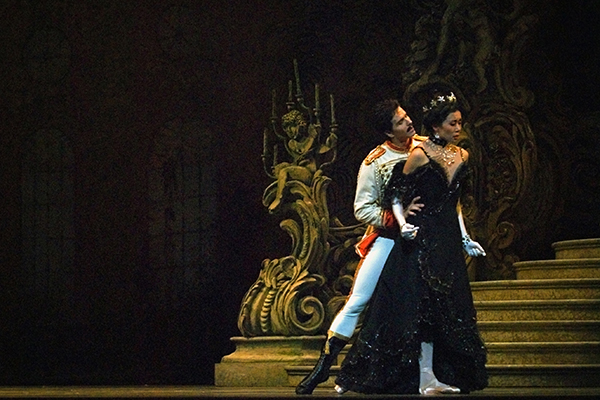Ballet
News+
The Merry Widow, All the Grandeur of the Belle Epoque
by Catherine Kustanczy
May 24, 2019

The Merry Widow conjures lush images of society life from a bygone era, with grand designs and opulent waltzes. Franz Lehár’s 1905 operetta Die lustige Witwe revolves around the romantic entanglements of Hanna Glawari (the rich widow of the title), who, in an attempt to prevent economic disaster in her home principality of the fictitious Pontevedro, is guided into involvement with fellow countryman Count Danilo, who had been a childhood sweetheart.
The work is based on an 1861 play, L'attaché d'ambassade (The Embassy Attaché) by Henri Meilhac, which focuses on the attempts by a Parisian ambassador of a poor German principality to arrange a marriage between a wealthy French widow and a Count in order to keep her money safely in the country.
Adapted into a German play in 1862 (Der Gesandschafts-Attaché), the work enjoyed numerous successful productions across Europe before writer Leo Stein came across it in 1905 and suggested it to his colleague, Viktor Léon, as well as to the manager of the famed Theater an der Wien, who was keen on a production. Thus, the pair updated the setting of the original play to Paris – complete with a move of the Count’s retreat to the glamorous and lively Paris nightclub Maxim’s – and transformed the original gloomy German principality into the fictional Pontevedro. A larger narrative, exploring the earlier relationship between the widow and the Count, was also developed, along with subplots that helped to color in the gracious character of the widow herself.
With a playful melding of styles within the score, the work lends itself to dance translation. Some of the operetta’s most famous works are present, including the jaunty duet “Ich bin eine anständige Frau” (“I am a respectable woman”) and is given loving orchestrations, presented with choreography every bit as flirty as the original lyrics. The ebullient “Weibermarsch” (“The Women’s March”) is also featured, a work largely associated with the operetta for its melodic fluency, though its bouncy, dance-like nature makes it a natural fit for choreographic adaptation.
The score also references various folk elements that retain their Balkan, Russian, and Polish flavors. Lehár had incorporated various Eastern European sounds into his earlier works, and, with the libretto referencing the fictitious “Pontevedro,” he knew incorporating those sounds with the ones of Western Europe, and France especially, would create a vivid sonic mix at once familiar and exotic to audiences – one hears the sound of the polonaise and the kolo (a Southern Slavic dance), alongside the cancan and waltz. This sonic quilt not only contributed to the operetta’s success and long-lasting appeal but underlined its connection to dance and movement.
Sir Robert Helpmann, an Australian actor, dancer, theatre director and choreographer, was keen to adapt the operetta for ballet. After gaining permission from the heirs of Lehár, Léon, and Stein, he reworked the staging and scenario. The operetta’s bouncy score was adapted and orchestrated by John Lanchbery, who had been Principal Conductor of The Royal Ballet from 1959 to 1972 and was Principal Conductor of The Australian Ballet from 1972 to 1977, together with his colleague, Alan Abbott.
English dance artist Ronald Hynd created the choreography, and the work was premiered at the at the Palais Theatre in Melbourne in 1975. A second version, presented in 1988, is by Veronica Paeper for the Cape Town City Ballet Company.
Hynd’s work has been presented by 17 different companies, including American Ballet Theatre, The Joffrey Ballet and Teatro alla Scala, to name a few. It entered the repertoire of The National Ballet of Canada in 1986, where it has remained a perennial crowd pleaser. The sparkling staging by John Meehan and Steven Woodgate and decadent set and costumes by designer Desmond Heeley, give audiences a taste of the opulent early 20th century Europe in which it is set.
A number of famous names have performed in the title role, including Dame Margot Fonteyn in 1976. National Ballet Principal Dancer Xiao Nan Yu is set to appear in the current production and it will be a bittersweet turn, as the role marks Yu’s retirement after 22 years with the company. Yu has performed in a number of classic as well as contemporary works, including The Sleeping Beauty, Swan Lake, The Nutcracker, Giselle, Romeo and Juliet, and many more. Her Hanna is, by turns, lively, sensuous, graceful, and very smart, capturing every bit of the romance and beauty of the original operetta.
The Merry Widow is onstage June 19 – 23, 2019.